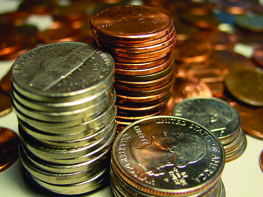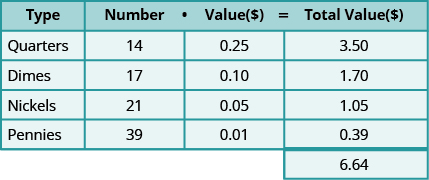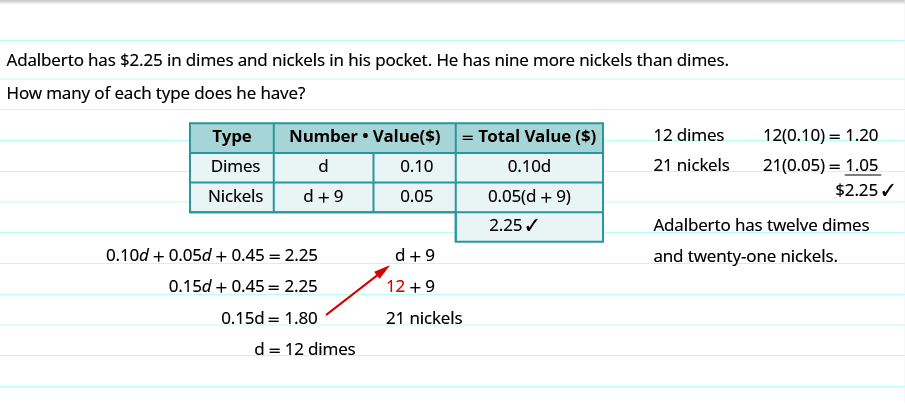| << Chapter < Page | Chapter >> Page > |
Before you get started, take this readiness quiz.
In mixture problems , we will have two or more items with different values to combine together. The mixture model is used by grocers and bartenders to make sure they set fair prices for the products they sell. Many other professionals, like chemists, investment bankers, and landscapers also use the mixture model.
We will start by looking at an application everyone is familiar with—money!
Imagine that we take a handful of coins from a pocket or purse and place them on a desk. How would we determine the value of that pile of coins? If we can form a step-by-step plan for finding the total value of the coins, it will help us as we begin solving coin word problems.
So what would we do? To get some order to the mess of coins, we could separate the coins into piles according to their value. Quarters would go with quarters, dimes with dimes, nickels with nickels, and so on. To get the total value of all the coins, we would add the total value of each pile.

How would we determine the value of each pile? Think about the dime pile—how much is it worth? If we count the number of dimes, we’ll know how many we have—the number of dimes.
But this does not tell us the value of all the dimes. Say we counted 17 dimes, how much are they worth? Each dime is worth $0.10—that is the value of one dime. To find the total value of the pile of 17 dimes, multiply 17 by $0.10 to get $1.70. This is the total value of all 17 dimes. This method leads to the following model.
For the same type of coin, the total value of a number of coins is found by using the model
where
number is the number of coins
value is the value of each coin
total value is the total value of all the coins
The number of dimes times the value of each dime equals the total value of the dimes.
We could continue this process for each type of coin, and then we would know the total value of each type of coin. To get the total value of all the coins, add the total value of each type of coin.
Let’s look at a specific case. Suppose there are 14 quarters, 17 dimes, 21 nickels, and 39 pennies.

The total value of all the coins is $6.64.
Notice how the chart helps organize all the information! Let’s see how we use this method to solve a coin word problem.
Adalberto has $2.25 in dimes and nickels in his pocket. He has nine more nickels than dimes. How many of each type of coin does he have?
Step 1. Read the problem. Make sure all the words and ideas are understood.

Step 2. Identify what we are looking for.
Step 3. Name what we are looking for. Choose a variable to represent that quantity.
Next we counted the number of each type of coin. In this problem we cannot count each type of coin—that is what you are looking for—but we have a clue. There are nine more nickels than dimes. The number of nickels is nine more than the number of dimes.
Fill in the “number” column in the table to help get everything organized.

Now we have all the information we need from the problem!
We multiply the number times the value to get the total value of each type of coin. While we do not know the actual number, we do have an expression to represent it.
And so now multiply See how this is done in the table below.

Notice that we made the heading of the table show the model.
Step 4. Translate into an equation. It may be helpful to restate the problem in one sentence. Translate the English sentence into an algebraic equation.
Write the equation by adding the total values of all the types of coins.

Step 5. Solve the equation using good algebra techniques.
| Now solve this equation. |
 |
| Distribute. |
 |
| Combine like terms. |
 |
| Subtract 0.45 from each side. |
 |
| Divide. |
 |
| So there are 12 dimes. | |
| The number of nickels is . |
 |
 | |
| 21 |
Step 6. Check the answer in the problem and make sure it makes sense.
Does this check?
Step 7. Answer the question with a complete sentence.
If this were a homework exercise, our work might look like the following.


Notification Switch
Would you like to follow the 'Elementary algebra' conversation and receive update notifications?